Top>Research>Testimony uncovers Okinawa
 Index
Index
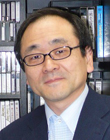
Ryoichi Matsuno [profile]
Education Course
Testimony uncovers Okinawa
Ryoichi Matsuno
Professor, Faculty of Policy Studies, Chuo University
Areas of Specialization: Media Theory and Journalism Theory
5 Years of Surveys to Publish a Collection of Testimonies
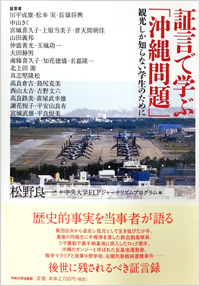
Collection of testimonies on Okinawan issues. The result of 5 years of project activities.
Since 2008, as part of the FLP Journalism Program, I have overseen a project to record testimonies related to Okinawan issues. This project has made significant progress and I published results in a book entitled Uncovering Okinawa through Testimony—For students who only know tourism (Chuo University Press). A total of 30 students participated in the project over a period of about 5 years, visiting Okinawa and conducting surveys. The book contains the testimonies of 26 people related to Okinawan issues.
Testimonies are composed of the following 3 categories: Section 1) the Okinawa ground war (the Battle of Okinawa), Section 2) post-WWII Okinawa, and Section 3) Okinawa and United States military bases. The surveys succeeded in unearthing new testimonies and recording testimonies of events which are in danger of being forgotten with the passage of time.
“I will talk because students come all the way from Tokyo.”—This feeling was expressed by some of the Okinawans who gave a testimony for the first time. People survey included a man who narrowly escaped mass suicide and grew up as an orphan, a rock musician who broke into Kadena Air Base and burned the car of an American soldier during the Koza Riot, and a member of the Tekketsu Kinnotai (Blood and Iron Corps) who gave a hand grenade to a seriously injured comrade.
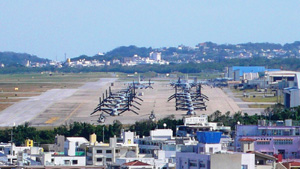
A group of Osprey aircraft stationed at Marine Corps Air Station Futenma (taken in February 2014).
The book also contains testimonies for Okinawan issues which are in danger of being forgotten with the passage of time. Such themes include wartime malaria and the Military army Nakano School, the wartime shipwreck on the Senkaku Islands, an anti-military base protestor known as the “Okinawan Gandhi,” and Masu Shima, the “mother of social welfare in Okinawa.”
Students also attempted to survey contemporary Okinawan issues which were thought to be a difficult subject to cover. They succeeded in recording several important testimonies. Example themes include the secret Okinawan treaty (leakage of a secret treaty by the Ministry of Foreign Affairs) and the issue of relocating Marine Corps Air Station Futenma to Henoko.
Why Okinawan Issues?
Personally, television played a great role in creating awareness for Okinawan issues in my generation. From when I was a student in elementary school to high school, Okinawan issues were a constant theme on television. Events covered the departure of B-52 Bombers from Kadena Air Base for air raids on Vietnam, the Koza Riots, the secret Okinawan treaty, the reversion of Okinawa to Japan, and the resignation of Prime Minister Eisaku Sato. From Japan’s defeat in WWII and occupation by the US army to American military bases, civilian protests and America’s global strategy, there is no denying that Okinawa increased the awareness of my generation.
So, why did I select Okinawan issues for a project in the FLP seminar? The reason is that I realized that students have a very low awareness for Okinawan issues, despite them being an extremely important theme in journalism.
Different problems can be seen in students born in Okinawa Prefecture and students born elsewhere in Japan. When a student born outside of Okinawa thinks of Okinawa, the list usually goes something like this: beautiful emerald-green water, unique Ryukyu culture, Okinawan cuisine, and then US military bases. In other words, Okinawa’s image as a tourist spot is given preference.
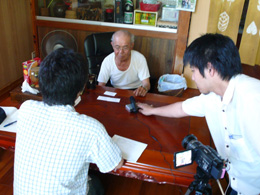
Students survey farmers about Shoko Ahagon, who was known as the “Okinawan Gandhi.” (Ieshima Island)
Students born in Okinawa have a different problem. From elementary school, students take classes on local issues such as the ground war and US military bases. Conversely, this has the effect of creating a psychologically saturated state and students fail to gain special interest in such familiar issues. Instead, they are thrilled to have come to Tokyo and complain about having to once again address the issues of rural Okinawa.
Put simply, students born outside of Okinawa focus on the image of a tourist spot and avoid the prefecture’s darker issues. On the other hand, in the case of students born in Okinawa, WWII and military bases are such “common issues” that they fail to be interesting. One thing that both groups of students have in common is that they would much rather enjoy a barbecue on a beautiful beach than discuss WWII and military bases.
I planned an overnight seminar workshop in Okinawa which allowed students to enjoy barbecuing on a beach on the condition that we visit 3 sites related to the Battle of Okinawa—the trenches of the former Japanese naval headquarters, Himeyurinotou (The Tower of Lilies), and Peace Memorial Park. At these sites, students had the opportunity to speak and interact with guides and narrators. Thanks to this introductory tour, awareness among students gradually heightened. This helped to widen the range of debate regarding issues such as the Okinawa ground war and the relocation of Marine Corps Air Station Futenma to Henoko. In this way, “students who know only tourism” actually started a project to record testimony for the benefit of other “students who know only tourism.”
Wartime Malaria and the Nakano School
I would now like to discuss the final theme which was surveyed as a testimony for the recently published book, as well as the growth of the student responsible for the survey.
Tomoya Nozaki (currently a 4th-year student at the Faculty of Policy Studies; 2nd-year student at the time of the survey) handled the theme of “Yaeyama Wartime Malaria and the Military Army Nakano School.” When thinking of the Battle of Okinawa, the ground war on the main island of Okinawa usually comes to mind. However, on the Yaeyama Islands, more than 3,500 people perished due to a malaria epidemic caused by a military order for forced evacuation. It has been pointed out that the Nakano School played a role in this chain of events from forced evacuation and malaria infection to the deaths of many civilians. In February 1945, Torao Yamashita (alias; 24 years old at the time) arrived on Hateruma Island as an instructor for the Young Men’s School. It is said that Yamashita was initially popular for his kind demeanor. In late March, the Japanese army issued an evacuation order to the Haemi District. However, this order was opposed by islanders who knew that there were confirmed cases of malaria in the Haemi District and remembered that a former village had been abolished due to a malaria epidemic. “In response, his face stained red with anger, Yamashita threatened to cut down with his katana anyone who opposed the order. ‘If you don’t comply with the evacuation order, I will poison the wells and burn your homes,” threatened Yamashita. “If even one person remains on the island, I will kill every last one of you.’” (History of Okinawa, Volume 10)
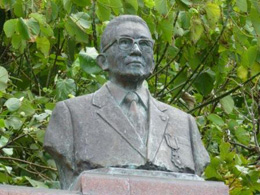
A bronze statue of principal Shikina stands on Haemida Beach, Iriomote Island. The statue is gazing at Hateruma Island in the distance.
Eventually, residents of Hateruma Island began evacuating to Iriomote Island on April 8th. Unfortunately, malaria soon began to run riot. Fearing the death of all residents on the island, Shinsho Shikina, principal of Hateruma Elementary School, pleaded for a return to Hateruma Island by making two direct visits to the brigade commander who had jurisdiction over the Yaeyama District. After finally receiving permission, residents returned to Hateruma on August 7th. However, there was no stopping the malaria epidemic. Malaria infected 99.8% of the island’s populations, or 1,587 out of 1,590 people. Ultimately, 477 people died, equivalent to about 30% of the island’s population. (Yaeyama Regional Welfare and Public Health Center)
Nozaki interviewed Zenko Nakasoko (79 years old; 10 years old at the time of the evacuation), who was a student of principal Shikina and became infected with malaria. Nakasoko shared his vivid memories of Yamashita.
“I was in the 4th grade of elementary school when Yamashita suddenly came to Hateruma Island. He was a very good looking man who captured the eye of all the women on the island. He quickly became famous across the island. Then, after receiving the evacuation order, Yamashita suddenly changed dramatically. He drew his military sword and threatened the islanders. As a child, I felt betrayed and wondered why he had suddenly become a different person. Since all of the island’s young men had been drafted into the military, only children, women and the elderly remained on Hateruma. There was no one left to resist Yamashita. He even ordered us to kill all of our livestock. However, the children, women and elderly lacked the strength to carry out the killings.”
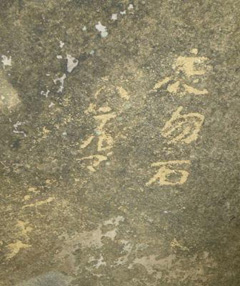
Wasurenaishi on Haemida Beach, Iriomote Island. Pouring white sand on Wasurenaishi makes the writing visible.
Nakasoko also testified to how a student died on Iriomote Island due to physical punishment.
“While living on Iriomote Island due to the evacuation, students were given a bamboo tube by Yamashita and told to kill flies. If we were unable to fill the tube with flies, we were beaten with the tube. Acting on the order given by Yamashita, a teacher at elementary school relentlessly beat an older student who failed to fill the tube with flies. The student’s wounds became infected and he died of a high fever. I will never forget the incident.”
Before returning to Hateruma Island from the evacuation to Iriomote Island, Principal Shikina carved a stone monument (Wasurenaishi) on the shore of the island’s Haemida Beach. Although Nozaki visited Wasurenaishi, he was unable to find the words carved into Wasurenaishi.
“I was unable to read the words on Wasurenaishi,” explained Nozaki in his report. “However, when I poured white sand on the rock, the characters finally become visible—‘Wasurenaishi Hateruma. Shikina.’ Someday, this message will become unreadable, but we must never forget the tragedy of Hateruma Island.”
Nozaki concluded his project report with the following statement.
“Everyone involved in the incident harbored hatred towards Yamashita. However, at the same time, they described Yamashita himself as a victim of the war. I believe that this description accurately portrays the kindness of people in the Yaeyama District, as well as the essence of the Hateruma incident.”
Conclusion
In February 2014, I traveled to Okinawa to take photographs for the front and back covers of the published collection of testimonies. I first visited Marine Corps Air Station Futenma in Ginowan City. A group of Osprey aircraft stood on the runway. Next I visited the Henoko District of Nago City, an area which is being considered for the relocation of the Marine Corps Air Station Futenma.
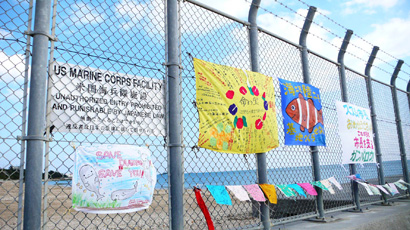
Beach of Henoko District in Nago City, an area being considered for relocation of Marine Corps Air Station Futenma. (photograph taken in February 2014)
The barbed wire fence which had divided the beach until just recently had been replaced with a large and sturdy fence. Colorful flags were tied to the fence. The phrase “life is the most precious thing in the world” caught my eye. Next to the phrase was a plate declaring the property a facility of the United States Marine Corps.
Okinawan issues continue to exist; indeed, we have yet to find any feasible approaches to a solution. I hope to ponder together with students for ways in which to solve the real issues, free from any ideologies or political positions.
- Ryoichi Matsuno
Professor, Faculty of Policy Studies, Chuo University
Areas of Specialization: Media Theory and Journalism Theory - Ryoichi Matsuno was born in 1956. He graduated from School of Education (Psychology), Kyushu University, and completed the University of Tsukuba Graduate School (counseling psychology). He holds a Ph.D. (Policy Studies) from Chuo University. Matsuno assumed his current position after working as a city news reporter at Asahi Shimbun, and as a TBS producer. From 1996 to 1997, He had been a visiting researcher at Harvard University (Fulbright Program). One of his research themes is about the relationship between media representation activities and capacity development exercises. His publications include Citizen Media Theory (Nakanishiya Shuppan). Edited works include Cultivating Human Ability through Film Production (Taken Publishing). Translated works include Public Access Television: America’s Electronic Soapbox (Chuo University Press). The Ryoichi Matsuno Seminar has won numerous awards including the Good Design Award, the Podcasting Excellence Prize Award, The Age of Regionalism Video Festival Excellence Award, Hida Takayama Documentary Film Festival Grand Prize, Development Education/International Understanding Education Contest Foreign Minister Award, and the Tokyo Video Festival Tetsuya Chikushi Award. Every year, many of his seminar students join the media industry.
- Research Activities as a Member of Research Fellowship for Young Scientists (DC1), Japan Society for the Promotion of Science (JSPS) Shuma Tsurumi
- Important Factors for Innovation in Payment Services Nobuhiko Sugiura
- Beyond the Concepts of Fellow Citizens and Foreigners— To Achieve SDGs Goal 10 “Reduce Inequality Within and Among Countries” Rika Lee
- Diary of Struggles in Cambodia Fumie Fukuoka
- How Can We Measure Learning Ability?
—Analysis of a Competency Self-Assessment Questionnaire— Yu Saito / Yoko Neha - The Making of the Movie Kirakira Megane








